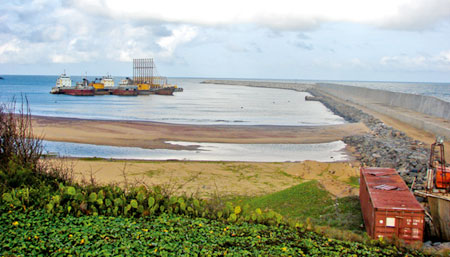Hambantota port, a big boost for industries
by Jayampathy JAYASINGHE
 |
|
Birds view of the
Hambantota port project |
There were at least 50 backhoe excavators at work dotting the vast
expanse of the land being excavated for the construction of the new
Hambantota Port project. The droning of the backhoe excavators at work
in the mid day could be heard up to where the observation platform had
been set up.
Work was in progress when we visited the new port site last week
accompanied by the Deputy Minister of Ports and Aviation, Dayasritha
Tissera. The construction work supervised by Chinese engineers, is
expected to be completed this year, marking a milestone in port
construction in Sri Lanka.
A mega project that will bring in economic prosperity not only to the
people in the southern province but to the whole country as well! Deputy
Minister Tissera said the Sri Lanka Ports Authority has signed a deal
with the China Harbour Engineering Company to launch the second phase of
the Hambantota Port in November.
Around 200-250 ships sail daily close to Hambantota. We hope to
attract at least one-sixth of the fleet to Hambantota for refuelling. By
August this year the port would be filled with water and arrangements
would be made this year or by the beginning of next year for a ship to
call over at the Hambantota harbour, he said.
He said the government plans to develop the Galle harbour as a
tourist attraction harbour and work at the Colombo south harbour is now
in progress. The government also held discussions with neighbouring
countries to develop the Trincomalee and Kankesanthurai harbours. “We
should have developed these harbours 15 years ago,” he said.

Sunila Rajawasam |

Muri Silva |

Prof. Jayanthi de Silva |

Indrachapa Balasooriya |
He said that some people had reservations about the Hambantota Port
project and considered it a daydream four years ago. However, they have
been proved wrong.
The Sri Lanka Ports Authority in consultation with the government
secured funds for the Port project. “We acquired land for the project
after paying compensation to the people. The Chinese government had also
realised the importance of this project,”
Major shipping lane
Hambantota, is in close proximity to a major shipping lane in the
Indian ocean. It extends from the Far East to Australia and cargo worth
billions of dollars from the Far East and Australia is shipped across to
the west on this route.
There are tremendous opportunities for Sri Lanka to rake in millions
of dollars from ships calling over at the Hambantota Port for bunkering
and refuelling. Today only a few ships de-tour and call over at the
Colombo Port for refuelling.
We visited the observation platform at the construction site that
enables viewers to get a glimpse of the entire project.
The platform is usually crowded with people on weekends, we were
told. We met some professionals while others were ordinary folk who
accompanied their children to show the work being carried out at the
port. The depth and scope of the work carried out by local engineers
under the supervision of Chinese experts is tremendous. The entire
project is due to be completed by the end of the year.
We spoke to a group of persons at the observation post. The former
Commissioner of Inland Revenue, Mrs. Indrachapa Balasooriya was among
them. She had come along with her friends to witness the construction
before the whole area gets inundated with water in September. “Having
read for Geography honours at the University of Peradeniya, I was keen
to see the work in progress.
The huge boulders excavated from the dam site can be made use for
construction rather than bringing them from outside. We are glad to see
that the best Port in South East Asia is being built at Hambantota. It
is an arid area where cultivation on a mass scale is not possible. A
port of this magnitude will provide jobs for those in the area,” she
said.
Employment opportunities
Mrs. Muri Silva, a former University lecturer, said the southern
province would be developed when the project is completed. It will
provide employment opportunities for the people. Retired Professor
Jayanthi de Silva said she was happy to see the development of the
southern port and hoped stage 2 and 3 of the project would also be
completed soon.
“We are from the south and happy to see that the south is being
developed. It has not been developed for a long time. The Ships sailing
here have bunkering facilities in the future,” said Mrs Sunila Rajawasam.
Engineer Senarath Rajawasm said “This was the first occasion I
visited the Hambantota Port. I worked at the Port Commission after my
initial training there. According to my experience, dredging the ground
while it is filled with water takes a long time and is also expensive.
But what is being done here is that the dredging is done after the water
and mud has been siphoned off.
It is fast, convenient and economical. It is also a good technique
that the Chinese experts have taught us. In a few months time the first
ship will be docked here. When the second phase is completed in 4-5
years’ time, the port will be fully operational to accommodate 33 ships.
container yard is also being built to stock containers,” he said.
We visited the bowels of the dam which are about 100 feet below
ground level. The excavation process is still under way while the water
and mud has been drained out. The ground at the bottom level remains
dry.
The bachoe cranes have removed huge boulders at ground level. Asked
how much of earth will be removed the Sri Lanka Ports Authority Engineer
, M.M.M.C. Bandara said 11 million cubic metres of soil would be removed
from an area of 85 hectares, during the first phase of the project.
Sri Lanka Ports Authority Engineer Agil Hewageegana said due to the
construction of the new port, the Hambantota-Kataragama road has been
closed temporally but the motorists can use other alternative routes to
go to Kataragama.
“We have acquired 1500 Hectares of land for the construction of the
new port complex. Even the Colombo Port consists of only 300 hectares.
We hoped to construct a small harbour in Hambantota initially. When the
second phase of the project is completed nine ships could be
accommodated. The depth of the harbour will be 17 metres. Huge boulders
excavated by backhoe cranes have been dumped in the sea, 4 miles away
from the Hambantota harbour in a depth of 60 metres.
The cost of the project is estimated to cost US dollars 360 million.
Meanwhile, a 14-storied building will also be constructed. Hewageegana
said that the 11 million cubic feet of earth excavated would be
deposited into the sea bed to make an island for tourism.
Catalyst for development
The Hambantota Port Development Project was initiated a few years ago
following several studies to assess its viability. Initially, Ms. SNC
Lavalin International of Canada undertook a preliminary study in 2003.
In 2005, the master plan for the Hambantota Port project was completed
by Ms Ramboll of Denmark.
The Hambantota port was planned initially as a services and
industrial port and to develop it subsequently as a transhipment port
with the increase of cargo volume. The construction of a port at
Hambantota, one of the less developed regions is seen as a catalyst for
major economic development in Sri Lanka. Hambantota is within 10
nautical miles of the world’s busiest shipping lane.
Estimates show that over 100 ships bypass Sri Lanka on their daily
voyage between Europe and the Far East.
Hambantota is well positioned and compared to any other Indian port
to act as a transshipment centre. Geographically Hambantota is ideally
located to serve domestic trade with a direct roadway connection to the
southern, central and eastern regions of the island. The port will also
pave the way to develop harbour-related industries such as ship-repair,
ship building, bunkering, oil refinery, power generation and a free
trade zone. |

